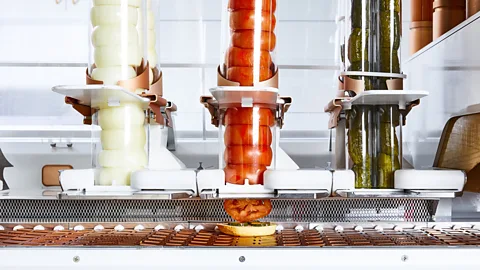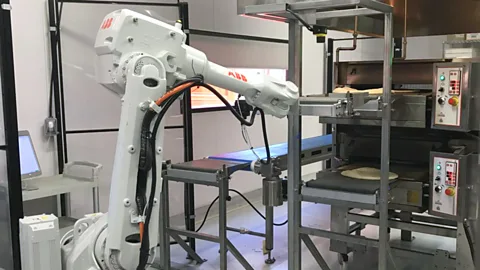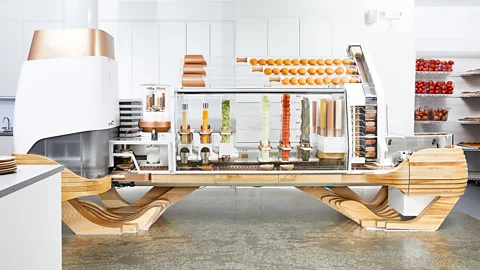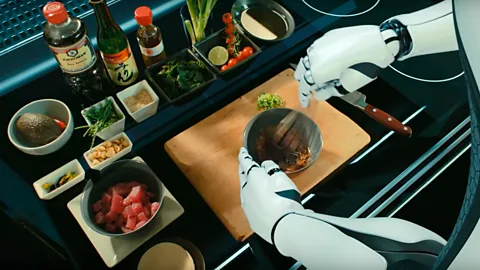The chef that can make a gourmet burger every 30 seconds
 Creator
CreatorRobots that can grill meat, slice tomatoes, stir fry vegetables and even stretch pizza dough are making fast food even faster, but would you trust a chef who has never tasted the food it creates?
There is a distinct lack of chopping, smoke, sweating or swearing in the kitchen at Creator, a new burger restaurant in San Francisco. Instead, there is faint whirring and, if you really listen, the muffled sound of grinding and distant sizzling. It’s because the chefs here are not human.
Creator instead uses two family car-sized robots that can each churn out 120 burgers an hour. They do everything from grinding the meat and shaping the burgers to slicing tomatoes, grating cheese and dispensing mustard. Each burger can be customised with different sauces, cheeses and toppings, while an array of sensors monitor the beef as it’s precision grilled.
The robots themselves are controlled by a machine learning algorithm that uses the information from 11 thermal sensors in the cooking compartment to help ensure each patty of meat is cooked just as the customer ordered it.
You might also like:
• Why machines dream of spiders with 15 legs
The burger robot has some 350 sensors, 50 actuators and 20 computers, according to Alex Vardakostas, the engineer behind Creator. Every aspect, from the ‘topping modules’ that measure out the condiments and garnishes to the vibrating blade that slice the buns cleanly, is designed for precision.
Creator is one of a small but growing number of restaurants turning to robotics and artificial intelligence to create a new experience for consumers. While the combination of robots and cooking might conjure the prospect of tasteless mass-produced meals, these machines are actually making food to order.
Precision cooking
At Creator, a tablet-based ordering system gives options for how well-done the burger should be, as well as selecting cheese, sauce and toppings. A range of exotic options include charred onion jam, two types of salt, and Pacific fusion sauce with umeboshi plum and mole (a Mexican sauce made with chilli and chocolate). The menu certainly takes a ‘foodie’ approach rather than offering production-line burgers, but the burgers are priced for the mass market, at around $6 each. This is supposedly made possible by saving on labour costs.
 Creator
Creator“Robotics enable us to do things the best way rather than the way they’ve always been done, optimizing beyond the constraints of by-hand operations,” says Vardakostas. “We use machine learning to improve the robot's culinary precision on things like cooking beef more precisely than a line cook does.
And their approach appears to have been well received. Reviewers have raved about the fresh, full-flavour of the burgers and “consistent” quality, although some have bemoaned a lack of juiciness.
The other benefit is the speed. Fast food is getting faster.
Buns are sliced open and then trundle along a glass-walled conveyor belt where sauces are squirted onto the bread, then tomatoes, onion and lettuce are freshly sliced on top. At the far end, the meat is ground, shaped and grilled on both sides at once using induction plates in a miniature cooking enclosure.
 Getty Images
Getty ImagesIt takes five minutes end to end, but as the robot can cook multiple burgers at once, a fresh meal can appear every 30 seconds when it is running at full speed.
Repeatable recipes
On the opposite side of the country, a new restaurant in Boston, Massachusetts is also using robots to do all the cooking. Spyce specialises in grain bowls, dishes which are quick-fried in a wok and served over rice, couscous or other cereals. Ordering is done via a display screen and as with Creator, the robotics are part of the show: a row of inductively-heated woks is positioned under a conveyor belt which automatically delivers ingredients to each bowl for rapid cooking before toppings are added by a human chef.
The entire process is completed in just three minutes. Again, the emphasis is on quality food at affordable prices, enabled by the speed and personalisation provided by machines.
But some are using robots in an attempt to resurrect interest in traditional cuisine. In China, entrepreneur Li Zhiming found few restaurants serve traditional Hunanese food, even in his home province of Hunan. Dishes like stir-fried cumin beef call for many fresh ingredients and a complex cooking process, and good chefs are hard to find. Li instead spent several years developing robots that could produce dishes using precise, repeatable recipes. Robotic hoppers dispense precisely-measured ingredients into a wok in sequence as they are stirred over a gas flame for precise lengths of time.
Li says instead of the usual staff of eight, his kitchen has three robots and two human ‘helpers’. He claims it will allow him to deliver Hunanese food to the same quality anywhere in the world.
Fast and fresh
Robot restaurants have novelty value, and watching a machine make your meal is part of the appeal. But Zume Pizza in California are working on the strictly practical application of robotics to fast food. Zume bakes pizza in vans en route to the customer, for the fastest, freshest pizza delivery possible. The company has steadily automated their pizza creation process with the addition of robot ‘co-workers’.
Zume’s ‘doughbot’ stretches pizza dough in nine seconds, rather than the usual forty-five, robots ‘Pepe’ and ‘Giorgio’ dispense sauces, ‘Marta’ spreads the sauce and robot arms ‘Bruno’ and ‘Vincenzo’ move pizzas in and out of the oven. Machine vision algorithms, combined with temperature sensors help to ensure the pizza is cooked perfectly. Using machine learning to analyse ordering data, they are also able to forecast how many ingredients they need to carry in the delivery van each night, while other algorithms coordinate the cooking time with the delivery route.
In April, Zume announced plans to license their technology. If their business model works, then pizzas made by robots may become very much more widespread. Meanwhile its rival Little Caesar, one of America’s biggest pizza chains, recently patented their own pizza-making robot.
But this new wave of automation could also signal a seismic shift in the way the fast-food industry employs people.
 Zume Pizza
Zume Pizza“It makes sense to automate non-value adding jobs to enable staff to focus on providing great customer service,” says Steve Newton, an expert on the fast-food sector at payment processing firm Worldpay. A recent Worldpay survey found that only 6% of UK customers were satisfied with the pace and efficiency of service while 58% would prefer a self-service kiosk if it speeded up service.
That does not necessarily mean fewer staff, but having more of them in roles where they can directly help customers, so there is always someone there when you need them.
“Successful business will not be cutting staff where it is to the detriment of customer service,” says Newton.
Some chains are already introducing touch-screen ordering, which can provide faster service as well as cutting staffing requirements. Robotic kitchens could have a similar impact on the efficiency and number of people needed in restaurant kitchens. An estimated 3.8 million people work in fast-food outlets in the US, the majority in repetitive, unskilled tasks which could potentially be automated.
A human touch
Richard Skellett is a technology entrepreneur and founder of Digital Anthropology, a social enterprise business that campaigns for technology to work for people rather than replace them. Skellett is sceptical of claims that robots in restaurants can create as many jobs as they displace.
“Just what are the jobs they are creating?” Skellett asks. “And do they exist in the same number as the jobs the automation is replacing?
“Technology should augment people, not replace them, AI and bots should free up people to add value to an enterprise.”
 Creator
CreatorCompanies like Zume claim that this is what they are doing.
“Our goal is to have automation handle repetitive, dangerous and boring tasks so our employees can focus on work that's more human,” says a spokesperson for Zume. She stresses that people will always be a key part of their business. “For example, a robot can't tell you if a pizza actually tastes good.”
Zume have also garnered plenty of good reviews for their pizza.
Newton points out that customers value speed, convenience and personalisation. This is already driving consumers to use table-booking apps on their phones, touchscreen ordering and paying online, and it is likely to favour increasingly automated kitchens too. But it may also mean more staff out front to improve service – especially for customers who prefer to deal with people rather than machines.
Vardakostas also argues that freeing up staff from the kitchen allows them to focus on customer service. “The goal is not to be the most automated restaurant,” he said. “It's to be the most human-centered restaurant."
But robotic cooks are not just limited to the kitchens of quirky fast-food restaurants. British company Moley Robotics plans to put robotic chefs in domestic kitchens too. Moley’s design features a pair of mechanical arms with eerily human-like robot hands, created by Shadow Robot Company, which specialises in humanoid robots.
 Moley Robotics
Moley RoboticsBy recording the actions of a human chef using a sophisticated motion-capture system, they can teach the machine to recreate their creations. The robots can perform dexterous tasks like whisking eggs, slicing onions or frying bacon. Moley claims to have a library of hundreds of different meals that owners can download, but the device comes at a cost, with an estimated price tag of £10,000.
But while these robots are currently reproducing human recipes, artificial intelligence may soon also start to influence the menu itself. Researchers at MIT set a neural network loose on a database of pizza toppings in an effort to discover new winning combinations. The top suggestions were baked by a pizza chef. The best it came up with – an unlikely shrimp, jam and Italian sausage combo – was actually rated quite highly by those who tasted it.
It is much too early to say whether any of this first wave of robo-chefs will thrive in such a demanding and unpredictable environment as the kitchen, but if they do, it could mark a change in our relationship with cookery.
Much like other activities that were once a necessary part of life before they were taken over by a machine, such as woodworking or needlecraft, cooking too could be something people choose to do simply for the sheer pleasure of it.
If you liked this story, sign up for the weekly bbc.com features newsletter, called “If You Only Read 6 Things This Week”. A handpicked selection of stories from BBC Future, Culture, Capital, and Travel, delivered to your inbox every Friday.
